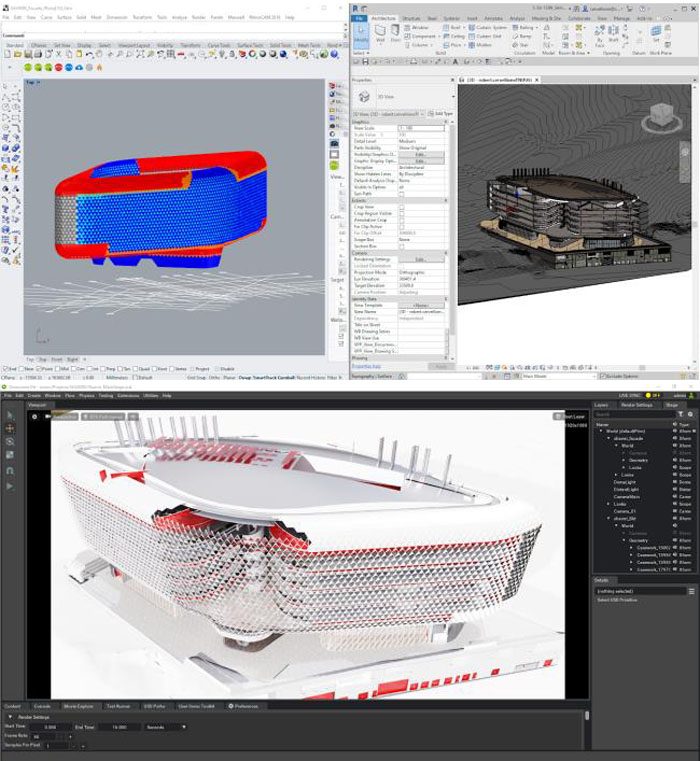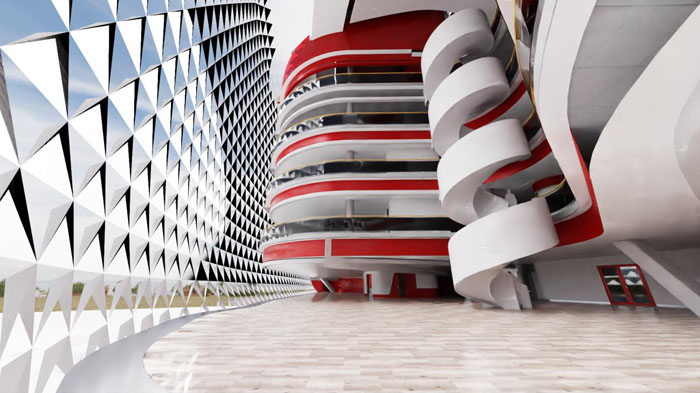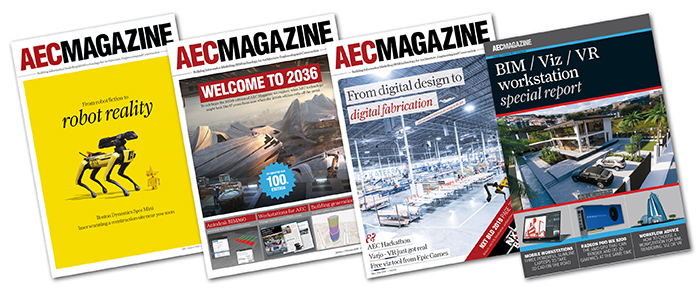New platform technology Nvidia Omniverse brings together architects and other stakeholders in a visually rich, real-time collaborative environment that has live links to the leading CAD and BIM tools. Greg Corke talked with Nvidia to find out more
A few years ago, Nvidia wowed its AEC and manufacturing customers with Holodeck, an experiment in using virtual environments for collaborative workflows. The platform was designed to bring together architects, designers and stakeholders from anywhere in the world to build and explore projects in a highly realistic, collaborative, and physically simulated VR environment.
The visual quality of the demonstration cars and buildings was stunning, but the 3D models represented a snapshot of a project in time. With distributed teams using many different tools, designs are constantly evolving, and a linear stepped process of import and export wasn’t going to solve the real workflow challenges faced by global AEC firms. What was needed was a dynamic way for data to be shared and Nvidia looked to the visual effects industry for inspiration.
Around the same time, Pixar brought out USD (Universal Scene Description), an open framework for the interchange of 3D computer graphics data, specifically focused on collaboration. As Richard Kerris, Industry GM for M&E at Nvidia, told AEC Magazine, USD “standardises toolsets and environments and models and all of the things that go into creating an object or an environment.”
USD was originally designed for visual effects and animation, but it immediately started to gain traction in other industries. It provided a means of transferring files without importing or exporting, but having it happen live between applications. “That was when the team looked at what was working and was not working with Holodeck and decided that, if they standardised around USD, they could take that same approach, but now have an environment of collaboration that comes through this open standard,” explains Kerris.
Holodeck was very focused on VR, but laid the foundations for a new, much broader, collaboration platform called Omniverse, which Kerris describes as “Google Docs for your world.”

Omniverse essentially allows teams to work together, interactively using their 3D design tools of choice. Data from multiple applications can be seamlessly streamed into the Omniverse and the resulting asset, be it a building, product or VFX scene, can be interacted with live in a real-time, ray-traced viewport accelerated by Nvidia Quadro RTX GPUs.
The AEC experience
Omniverse can serve multiple industries, including Media and Entertainment and manufacturing, but it’s the AEC market that’s getting the most attention, as Kerris explains. “AEC, in particular, really gravitated towards us because they’ve always had this strong need to collaborate, because sometimes the architectural firm is in London and the building is in Beijing, and some of the landscapers are in Shanghai and you know there’s all this stuff that goes back and forth.
“And so we started talking with all of the major players from Foster + Partners to KPF to Woods Bagot and we’ve made them into ‘lighthouse’ accounts, meaning that they’re in, and we work with them on a fairly regular basis, about how our development is going, what is important to them, how customers would use things.”
All of this has led to the development of the Omniverse AEC Experience, which provides firms with a collection of tools designed to improve the conceptual design process. “Multiple designers can work on one design at the same time and reviewers can ask for changes in real time,” explains Nvidia CEO Jensen Huang. There are live links or ‘Portal connections’ to the major 3D design tools, including SketchUp, Revit, and Rhino, and viz tools 3ds Max and Unreal Engine. As one would expect, there’s a big emphasis on high fidelity, ray traced models and the use of photorealistic visualisation much earlier on in the design process.
Kerris is keen to point out that Nvidia is not looking to make a product out of Omniverse. He explains that one of the guiding principles is for Independent Software Vendors (ISVs) to add, embellish and do whatever they want to do with it as a platform. In the AEC space, Nvidia has been working very closely with Autodesk, McNeel, Trimble and Epic Games but is also talking to others. An SDK called Omniverse Kit is available to help ISVs gives their products a real-time, ray-traced application viewport.

According to Andrew Rink, who leads global marketing strategy for AEC and manufacturing at Nvidia, one of the key breakthroughs Omniverse achieves is the ability to move among Revit, Rhino or SketchUp with just one click, “There’s no need for data preparation or decimation to view huge models with supported photorealistic rendering software. This eliminates costly delays in translation and errors between software tools, which results in substantial time savings,” he says.
“For instance, a team iterating on concepts might have an architect making changes to the building model using Revit, while a designer in another office simultaneously adds or modifies design elements using Rhino or Trimble SketchUp. All team members, and even their client, can view these changes in real time in Omniverse as they work together and exchange feedback.”
Kerris describes an example workflow where a global team is using a range of tools including Revit, Rhino, SketchUp and 3ds Max to work collaboratively on a building in China designed by KPF. Participants make changes to materials, windows and lights and various configurations within the scene. All of this is being managed in real time, across the globe.
“For the first time they’re really able to collaboratively work on an environment, not just like ‘OK you do this come back tomorrow when we’ve got that,’” says Kerris. “What’s really amazing is that in that platform you will see the object to build and you will see the environment, sunshine, clouds, etc. You will see photorealistic finishing and materials on the building, you’ll be able to come inside to the interiors and all of this will be taking place in real time.”
To support collaboration, users can leave notes, annotations and highlight objects. These are persistent within Omniverse. “We’re looking at what other ways are best,” says Kerris. “If you highlight something can it pop open a video of somebody that may not be dynamically connected at that time, but left you a Post-it Note, if you will, to say, ‘hey move this wall.’”

Nvidia omniverse broken down
Nvidia Omniverse features several key modules. Omniverse ‘nucleus’ coordinates all of the USD elements across the various applications, feeding into the rest of the platform. Any changes made in Revit, Rhino or another authoring tool are continually fed into Omniverse via ‘Connector plug-ins’ which create a live link. The Nucleus can run on a standard server or a VM within an Nvidia RTX Server.
Nvidia Omniverse ‘View’ provides a real time view into the Omniverse world that is being worked on. It uses Quadro RTX GPUs to provide high-quality photorealistic output of the aggregated USD model and offers basic scene and material editing capabilities as well as industry-specific features like light studies. All team members, even clients, can view changes in real time – the idea being that everyone can work together and exchange feedback. By being able to pan, zoom and rotate a photorealistic model in the viewport anyone can quickly see how light might reflect off a surface or a physically based material, such as wood or concrete, might look under various lighting conditions. “This is a tremendous help in accelerating design decisions, which leads to more time for ideating on innovative concepts and faster bid preparation,” says Rink.
Nvidia Omniverse View is not the only way to view photoreal content generated on the platform, as Kerris explains, “If you want to stay in Rhino, you can feed the viewport back into the application, so we’ve really created it in a way that the ISVs can take it and extend it.”
Viz asset generation isn’t limited to the Omniverse rendering engine. The platform is also designed to support commercial game engines and offline renderers, as Kerris explains. “We’re not changing workflows, we’re enhancing it, so if they go out to Unreal’s Twinmotion or they go to Chaos [Group], things like that, all of those things are built to be supported by Omniverse – they’re all partners.”

Powering the Omniverse
Omniverse View can run on a Quadro RTX desktop or mobile workstation allowing users to get an interactive viewport into the shared scene. However, the real power of the platform comes into play when using Nvidia RTX Server, a reference design available for a range of OEMs with up to eight or ten Nvidia Quadro RTX 6000 or 8000 GPUs.
RTX Server can perform multiple roles. It not only provides buckets of processing power for real time ray tracing, but with Nvidia Quadro Virtual Data Center Workstation (Quadro vDWS) software users can access the Omniverse platform using GPU-accelerated virtual machines. It means all collaborators, including clients, can view projects in full interactive ray traced quality on low powered hardware – laptop, tablet or phone. AEC firms can also run their 3D design tools directly off RTX Server.
Getting immersive
Nvidia Omniverse is not just for static displays – XR has a massive role to play. For example, an iPad can be used to window into an AR-based view of the building that’s sitting on a dining room table, “We not only support the streaming out of it, we support AR kit and things that allow you to have location based information so that you can use the viewer for more than just a portal, but actually something to interact with,” says Kerris. “The things we’re doing with AR are much higher fidelity than people have ever seen before and the feedback has been phenomenal.”
VR pixel streaming is on the roadmap and there will be support through its CloudXR platform, but Kerris believes AR has a more important role to play, “From a collaborative standpoint, the feedback has been much more positive. If you and I are collaborating on something we don’t need to have our headsets on, we’re literally working on a window and we can interact with it.”
Nvidia Omniverse and the cloud
The current focus for Nvidia Omniverse is for AEC firms to use on premise hardware but there are plans to add a cloud service. “We certainly have that capability, but we’re still working on how to implement that so that it’s in the best experience for the customers,” says Kerris. “One of the biggest points of feedback we’ve had from a lot of architectural firms is ‘we’re not big IT firms, we are architects, and so we want to use cloud services like we use Netflix.’”
Open access
Omniverse is currently being trialled by about 35 ‘lighthouse’ accounts. About a third are major architectural firms, says Kerris, but Omniverse isn’t just for the larger practices, “We’ve got all sizes there actually, there’s an architect working on [Nvidia CEO] Jensen’s house, and he got him enlisted. And then we have architects that are working on 70 storey buildings that are going to be iconic,” he says.
Now with the launch of Ominiverse AEC Experience, Nvidia is opening things up to more firms through an Early Access program. Kerris expects the number of firms to rise significantly, and not just architects. Nvidia is also starting to talk to other disciplines including structural engineers and MEP engineers.
Conclusion
AEC firms are well served by real-time viz applications – Enscape, Twinmotion and Lumion all offer live links to the major CAD and BIM tools and some also have support for RTX ‘real-time’ ray tracing. They do a great job of putting visualisation tools into the hands of architects but are very much personal tools for the creation of viz assets or for giving real time feedback on design decisions.
With Omniverse, Nvidia has much bigger ambitions – to bring together design teams in a visually rich collaborative environment where industry-standard 3D tools can be used concurrently to drive the design and all stakeholders, including clients get to see the impact of those decisions, instantly. And all of this is done in a photorealistic environment where the impact of light and materials can be explored from a very early stage.
Nvidia says the initial focus is on enhancing conceptual design, which implies that in the future the platform could be used further downstream. How this would work in practice remains to be seen, as when AEC projects evolve and details become more important, clashes and constructability issues need to be resolved. This looks a step too far for Omniverse itself but something that could be handled by tight integration with a third-party product like Revizto, Navisworks or Unity Reflect, which can handle BIM metadata.
It’s still very early days for Omniverse and there’s a lot we don’t yet know, but we’re excited to see where this technology goes and, more importantly, how the AEC firms who are helping shape its direction are getting on.
If you enjoyed this article, subscribe to our email newsletter or print / PDF magazine for FREE







